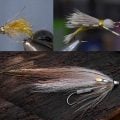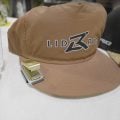How to Tie the CBC Green Machine
Producer: tightlinevideo
During a recent trip to the Gander River in Newfoundland to shoot a show with The New Fly Fisher, another guest at Gander River Outfitters told me about this pattern, called the CBC Green Machine. It’s similar to its cousin, the regular Green Machine, but has a yarn body as opposed to one of spun and clipped deer hair, so it’s much easier and faster to tie. Kevin, the guest, told me that CBC stands for “Come by Chance”, the name of a town in Newfoundland, and that he’s had great success with the fly fishing for both Atlantic salmon and sea-run trout.
The fly starts with a size 10 or 12 Mustad 9672 streamer hook. It also looks pretty good on a fairly standard salmon fly hook in the same sizes. Begin by getting the hook firmly secured in the jaws of your tying vise.
For thread, I’ve loaded a bobbin with a spool of fluorescent green UTC 140 Denier. You can go lighter if you like, but excess bulk really isn’t a problem with this pattern so I choose to go heavier to make the fly a little more durable. Get the thread started on the hook shank, leaving a small space behind the eye and, after taking a few wraps rearward, snip off the excess tag.
Medium-sized flat gold tinsel is used for the fly’s tip. I do prefer straight gold as opposed to the tinsel with gold on one side and silver on the other, as sometimes the gold and silver sides want to separate and cause problems. After cutting a 10” length, enough to make numerous flies, secure one end to the near side of the hook at the location of your tying thread. Then take smooth, touching wraps rearward to bind the tinsel to the near side of the hook, all the way back to the start of the bend that’s located about halfway between the hook point and the barb. Next, take touching thread wraps forward to about 1/4 of the way up the shank.
Start taking slightly overlapping wraps with the tinsel. Wrap further than you normally would for a tip, go about 1/3 of the way up the hook shank, as the gold is also going to become the bright underbody for the tag. Use tight wraps of tying thread to anchor the tinsel, then continue to take thread wraps to bind the tinsel to the near side of the hook, all the way up to the initial tie-in point. The goal is to create a smooth, even underbody on the fly. You can then snip the excess tinsel off close. Take slightly open wraps of tying thread down the hook shank until your thread hangs right at the hook point.
Fluorescent green or chartreuse floss is used to create the tag. A 10” length is enough to create a couple of flies. With about an inch-and-a-half of floss hanging off the back of the hook, secure the strand to the top of the shank then take thread wraps forward to a point just a bit longer than the gold tip. Bring the forward-pointing portion of the floss behind your tying thread and begin taking slightly overlapping, rearward wraps with it until you reach the gold tip. Then wrap forward to create a nice, even and smooth tag on the fly. When you reach your tying thread, use it to anchor the floss then pull that rearward segment of floss over top of the tag. This will hold it in place and keep the wraps from slipping rearward over top of the tip while you’re casting. Take a few more thread wraps to make sure the floss is bound down really well. You can then snip the excess floss off just past the hook eye, so it doesn’t get in the way so much as you take thread wraps forward to bind it to the top of the hook shank, all the way up to the initial tie-in point. Once again, the idea is to create a fairly smooth, even underbody on the fly. When you reach the initial tie-in point, lift the floss up and snip the excess off close.
For the body of the fly, I was told that kelly green yarn is the traditional choice, but I’m going to use some Insect Green Sparkle yarn which I think is pretty close. A 3-card width length of this 3 strand yarn is enough to make three flies. Separate the strands and get hold of one end of one of them. Take a few thread wraps rearward and give your bobbin a counterclockwise spin so your tying thread will want to jump rearward during a pinch wrap and catch the end of the yarn. Take touching wraps rearward to bind the yarn to the top of the hook shank. Be careful not to wrap over the tag like this, it’s easy to do because it’s almost the same color. Instead, wrap back to just the front edge of the tag. Then, again, wrap forward and try to maintain that smooth underbody on the fly as you go. I’ve got a little extra yarn poking out over the hook eye so I snip it off close. End with your tying thread a full eye-length behind the back edge of the hook eye.
Get hold of the yarn and take a wrap with it so it’s flattened out like floss. You can keep wrapping like this if you want, but I like to give the yarn a clockwise twist, as if I’m looking down on it, to cord it up a bit which then results in slightly larger segmented-looking wraps. Just before I get to my tying thread, I start untwisting the yarn to once again flatten it out. The whole process yields a somewhat cigar-shaped body on the fly, similar to the body on a traditional deer hair Green Machine. It’s subtle but I like the look. With the body complete, snip the excess yarn off close, then take a few tight thread wraps to cover up the end. Now that was a scary little thread slip right there. Again, end with your tying thread an eye-length back from the back edge of the hook eye.
A single brown hackle feather from either a cape or a saddle is used to hackle the fly. Before plucking the feather free, it’s a good idea to measure it first. I like to undersize the hackle on this size 12 to a 16 because of the built-up body on the fly. When you’re happy with the size, pluck the feather free from the skin. With the shiny side of the feather facing you, preen down the lower webby fibers then snip the lower part of the stem off. Trim the fibers on both sides of the stem into a small triangular tie-in anchor then strip a few more fibers from just the top side of the stem. Give your bobbin a good counterclockwise spin then lay the tie-in anchor against the near side of the hook and take nice tight thread wraps to secure it. End with your tying thread where you started, then pull the hackle feather forward out of the way. Give your bobbin a really good clockwise spin to cord up your tying thread and decrease its diameter. Make open spiral wraps with the thread down the hook shank, ending at the front edge of the floss tag. You can then get hold of the hackle feather and, after making a full 360 degree initial wrap, make open spiral wraps over top of the green body, 5 turns is kind of traditional and looks good. End at the front edge of the tag and take a few nice tight thread wraps to secure the feather’s tip there. When you’re done, either snip or break the excess hackle tip off close.
Once again, give your bobbin a clockwise spin to cord up, strengthen and thin your tying thread. Then make open spiral wraps up the body of the fly, wiggling your way as you go so as not to trap hackle fibers. Take a few more thread wraps to begin building up a neat head on the fly.
Rather than changing threads, I simply use a black permanent marker to change the color of my tying thread from bright green to black, then take wraps with the black thread to produce a black head on the fly. Next, reach for your whip finish tool and use it to do a 4 or 5 turn whip finish, seat the knot really well and snip or cut your tying thread free. A drop of head cement, here Sally Hansen Hard as Nails, applied to the thread wraps will ensure they don’t come unraveled and help to neaten up the head of the fly.
Your finished CBC Green Machine should look something like this. Once again, thanks to you Kevin for introducing me to such a cool little pattern.
How to Tie the Casual Dress
How to Tie the CDC & Elk











